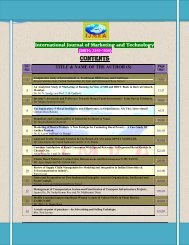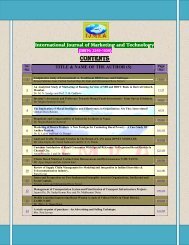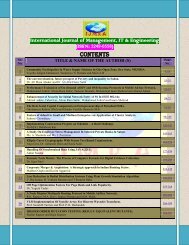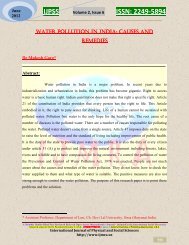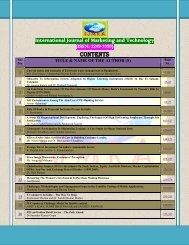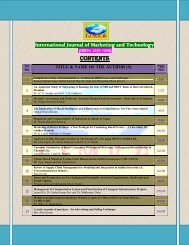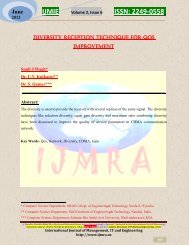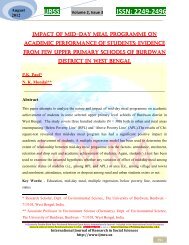ijrss - International Journals of Multidisciplinary Research Academy
ijrss - International Journals of Multidisciplinary Research Academy
ijrss - International Journals of Multidisciplinary Research Academy
Create successful ePaper yourself
Turn your PDF publications into a flip-book with our unique Google optimized e-Paper software.
February2012IJRSS Volume 2, Issue 1 ISSN: 2249-2496_________________________________________________________Editorial BoardDr. CRAIG E. REESEPr<strong>of</strong>essor, School <strong>of</strong> Business, St. Thomas University, Miami GardensDr. S. N. TAKALIKARPrincipal, St. Johns Institute <strong>of</strong> Engineering, PALGHAR (M.S.)Dr. RAMPRATAP SINGHPr<strong>of</strong>essor, Bangalore Institute <strong>of</strong> <strong>International</strong> Management, KARNATAKADr. P. MALYADRIPrincipal, Government Degree College, Osmania University, TANDURDr. Y. LOKESWARA CHOUDARYAsst. Pr<strong>of</strong>essor Cum, SRM B-School, SRM University, CHENNAIPr<strong>of</strong>. Dr. TEKI SURAYYAPr<strong>of</strong>essor, Adikavi Nannaya University, ANDHRA PRADESH, INDIADr. T. DULABABUPrincipal, The Oxford College <strong>of</strong> Business Management, BANGALOREDr. A. ARUL LAWRENCE SELVAKUMARPr<strong>of</strong>essor, Adhiparasakthi Engineering College, MELMARAVATHUR, TNDr. S. D. SURYAWANSHILecturer, College <strong>of</strong> Engineering Pune, SHIVAJINAGARDr. S. KALIYAMOORTHYPr<strong>of</strong>essor & Director, Alagappa Institute <strong>of</strong> Management, KARAIKUDIPr<strong>of</strong> S. R. BADRINARAYANSinhgad Institute for Management & Computer Applications, PUNEMr. GURSEL ILIPINARESADE Business School, Department <strong>of</strong> Marketing, SPAINMr. ZEESHAN AHMEDS<strong>of</strong>tware <strong>Research</strong> Eng, Department <strong>of</strong> Bioinformatics, GERMANYA Quarterly Double-Blind Peer Reviewed Refereed Open Access <strong>International</strong> e-Journal - Included in the <strong>International</strong> Serial DirectoriesIndexed & Listed at: Ulrich's Periodicals Directory ©, U.S.A., Open J-Gage, India as well as in Cabell’s Directories <strong>of</strong> Publishing Opportunities, U.S.A.<strong>International</strong> Journal <strong>of</strong> <strong>Research</strong> in Social Scienceshttp://www.ijmra.us205
February2012IJRSS Volume 2, Issue 1 ISSN: 2249-2496_________________________________________________________Mr. SANJAY ASATIDept <strong>of</strong> ME, M. Patel Institute <strong>of</strong> Engg. & Tech., GONDIA(M.S.)Mr. G. Y. KUDALEN.M.D. College <strong>of</strong> Management and <strong>Research</strong>, GONDIA(M.S.)Editorial Advisory BoardDr. MANJIT DASAssistant Pr<strong>of</strong>essor, Deptt. <strong>of</strong> Economics, M.C.College, ASSAMDr. ROLI PRADHANMaulana Azad National Institute <strong>of</strong> Technology, BHOPALDr. N. KAVITHAAssistant Pr<strong>of</strong>essor, Department <strong>of</strong> Management, Mekelle University, ETHIOPIAPr<strong>of</strong> C. M. MARANAssistant Pr<strong>of</strong>essor (Senior), VIT Business School, TAMIL NADUDr. RAJIV KHOSLAAssociate Pr<strong>of</strong>essor and Head, Chandigarh Business School, MOHALIDr. S. K. SINGHAsst. Pr<strong>of</strong>essor, R. D. Foundation Group <strong>of</strong> Institutions, MODINAGARDr. (Mrs.) MANISHA N. PALIWALAssociate Pr<strong>of</strong>essor, Sinhgad Institute <strong>of</strong> Management, PUNEDr. (Mrs.) ARCHANA ARJUN GHATULEDirector, SPSPM, SKN Sinhgad Business School, MAHARASHTRADr. NEELAM RANI DHANDAAssociate Pr<strong>of</strong>essor, Department <strong>of</strong> Commerce, kuk, HARYANADr. FARAH NAAZ GAURIAssociate Pr<strong>of</strong>essor, Department <strong>of</strong> Commerce, Dr. Babasaheb Ambedkar MarathwadaUniversity, AURANGABADA Quarterly Double-Blind Peer Reviewed Refereed Open Access <strong>International</strong> e-Journal - Included in the <strong>International</strong> Serial DirectoriesIndexed & Listed at: Ulrich's Periodicals Directory ©, U.S.A., Open J-Gage, India as well as in Cabell’s Directories <strong>of</strong> Publishing Opportunities, U.S.A.<strong>International</strong> Journal <strong>of</strong> <strong>Research</strong> in Social Scienceshttp://www.ijmra.us206
February2012IJRSS Volume 2, Issue 1 ISSN: 2249-2496_________________________________________________________Pr<strong>of</strong>. Dr. BADAR ALAM IQBALAssociate Pr<strong>of</strong>essor, Department <strong>of</strong> Commerce, Aligarh Muslim University, UPDr. CH. JAYASANKARAPRASADAssistant Pr<strong>of</strong>essor, Dept. <strong>of</strong> Business Management, Krishna University, A. P., INDIATechnical AdvisorsMr. Vishal VermaLecturer, Department <strong>of</strong> Computer Science, Ambala, INDIAMr. Ankit JainDepartment <strong>of</strong> Chemical Engineering, NIT Karnataka, Mangalore, INDIAAssociate EditorsDr. SANJAY J. BHAYANIAssociate Pr<strong>of</strong>essor ,Department <strong>of</strong> Business Management, RAJKOT, INDIAMOID UDDIN AHMADAssistant Pr<strong>of</strong>essor, Jaipuria Institute <strong>of</strong> Management, NOIDADr. SUNEEL ARORAAssistant Pr<strong>of</strong>essor, G D Goenka World Institute, Lancaster University, NEW DELHIMr. P. PRABHUAssistant Pr<strong>of</strong>essor, Alagappa University, KARAIKUDIMr. MANISH KUMARAssistant Pr<strong>of</strong>essor, DBIT, Deptt. Of MBA, DEHRADUNMrs. BABITA VERMAAssistant Pr<strong>of</strong>essor, Bhilai Institute Of Technology, DURGMs. MONIKA BHATNAGARAssistant Pr<strong>of</strong>essor, Technocrat Institute <strong>of</strong> Technology, BHOPALMs. SUPRIYA RAHEJAAssistant Pr<strong>of</strong>essor, CSE Department <strong>of</strong> ITM University, GURGAONA Quarterly Double-Blind Peer Reviewed Refereed Open Access <strong>International</strong> e-Journal - Included in the <strong>International</strong> Serial DirectoriesIndexed & Listed at: Ulrich's Periodicals Directory ©, U.S.A., Open J-Gage, India as well as in Cabell’s Directories <strong>of</strong> Publishing Opportunities, U.S.A.<strong>International</strong> Journal <strong>of</strong> <strong>Research</strong> in Social Scienceshttp://www.ijmra.us207
FebruaryIJRSS Volume 2, Issue 1 ISSN: 2249-24962012_________________________________________________________Abstract:This article is based on a sample study conducted among 300 cardamom planters in three statesviz., Tamil Nadu, Kerala and Karnataka. The study was conducted so as to understanding thecultivation practices <strong>of</strong> cardamom with a view to provide an understanding to help decisionmaking <strong>of</strong> cardamom growers. As such the study has revealed the practices in cardamomcultivation in terms <strong>of</strong> the area under cultivation <strong>of</strong> cardamom, inter- cropping adopted,cardamom varieties chosen for cultivation, seasonality <strong>of</strong> cardamom cultivation, high yieldingvarieties, borrowing for cultivation, replantation, span <strong>of</strong> cardamom plant, irrigation, manuring,soil testing, application <strong>of</strong> pesticides and harvesting, and post-harvesting. The study hassuggested some measures based on the findings, that would help the cardamom growers in threestates to make decisions with regard to quantity and quality <strong>of</strong> cardamom production.Key Words: Cardamom Cultivation, Practices, Plantation, Production.Introduction:Cardamom is one <strong>of</strong> the oldest spices in the world, and the most popular spice in ancientRome was probably cardamom. By the first century AD, Rome was importing substantialquantity <strong>of</strong> cardamom from India. Today cardamom is cultivated in India, Nepal, Srilanka,Guateamala, Mexico, Thailand and Central America. Cardamom cultivation in India isconcentrated mainly in those regions which form the natural habitat <strong>of</strong> the species, except for asmall area in Maharashtra where it is grown as a subsidiary crop in the arecanut gardens.Approximately, 40,500 ha <strong>of</strong> area scattered throughout the hill forest zone <strong>of</strong> the Western Ghatsis under cardamom. Around 50 per cent <strong>of</strong> the area lies in the cardamom hills in Travancore –Cochin, some 23 per cent in Shimoga, Hasan and Chikmaglur Districts, 13 per cent in KodaguDistrict in Karanataka and 13 per cent in Tamil Nadu in the southern foothills <strong>of</strong> the Nilgiris andthe Anamalai, the Nelliampatty and the Kodaikanal hills. It was only after the formal invitationby the Travancore Maharaja, in the 1850s, the crop it was commercially cultivated in the forests<strong>of</strong> the Western Ghats in Kerala.A Quarterly Double-Blind Peer Reviewed Refereed Open Access <strong>International</strong> e-Journal - Included in the <strong>International</strong> Serial DirectoriesIndexed & Listed at: Ulrich's Periodicals Directory ©, U.S.A., Open J-Gage, India as well as in Cabell’s Directories <strong>of</strong> Publishing Opportunities, U.S.A.<strong>International</strong> Journal <strong>of</strong> <strong>Research</strong> in Social Scienceshttp://www.ijmra.us209
February2012IJRSS Volume 2, Issue 1 ISSN: 2249-2496_________________________________________________________Agricultural production has to cross through uncertainty and vagaries <strong>of</strong> seasonalparameters. There is great risk and uncertainty on account <strong>of</strong> drought, floods, pest and disease.On the other hand, it requires a large proportion <strong>of</strong> land than do other industries require. There isalso a possibility <strong>of</strong> getting diminishing returns while increasing the application <strong>of</strong> inputs likefertilizer. Moreover, farming requires speedy decision on the part <strong>of</strong> the farmer and farmworkers. It is more so in cardamom cultivation. When there is a heavy rainfall the farmer shouldtake immediate decision about controlling certain diseases like capsule rot (Azhukal). Cardamomis seasonal in production. There is wide variation in yield. This affects the estimates <strong>of</strong>production and thus production plan has to face much risk components, which are not the casewith industries. Further, agricultural produce like cardamom can not be produced exactly thesame in size, form and quality. This affects the grading and standardization practices. Againstthese hurdles, cardamom growers have to make attempts to succeed in their agribusinessactivities. In this context, it would be <strong>of</strong> interest to study the cultivation, practices <strong>of</strong> cardamomwith a view providing an undertaking to help decision making <strong>of</strong> cardamom growers. Againstthis background an attempt has been made to understand the practices <strong>of</strong> cardamom cultivationin terms <strong>of</strong> the area under cultivation <strong>of</strong> cardamom, inter- cropping adopted, cardamom varietieschosen for cultivation, seasonality <strong>of</strong> cardamom cultivation, high yielding varieties, borrowingfor cultivation, replantation, span <strong>of</strong> cardamom plant, irrigation, manuring, soil testing,application <strong>of</strong> pesticides and harvesting, and post-harvesting.Objectives:1. To understand the cardamom cultivation process such as area under cardamomcultivation, cropping pattern, plantation, re-plantation, irrigation, mannuring, pest controlmanagement, harvesting and Post harvesting technologies <strong>of</strong> small cardamom in Kerala,Karnataka and Tamil Nadu.2. To identify the problems <strong>of</strong> cardamom growers and <strong>of</strong>fer suitable suggestions based onthe findings.A Quarterly Double-Blind Peer Reviewed Refereed Open Access <strong>International</strong> e-Journal - Included in the <strong>International</strong> Serial DirectoriesIndexed & Listed at: Ulrich's Periodicals Directory ©, U.S.A., Open J-Gage, India as well as in Cabell’s Directories <strong>of</strong> Publishing Opportunities, U.S.A.<strong>International</strong> Journal <strong>of</strong> <strong>Research</strong> in Social Scienceshttp://www.ijmra.us210
FebruaryIJRSS Volume 2, Issue 1 ISSN: 2249-24962012_________________________________________________________Methodology:This study is a comprehensive and analytical study based on sampling technique. Thestudy adopted multistage random sampling in the selection <strong>of</strong> 300 sample respondents. Threestage selection <strong>of</strong> sample is as follows. In the first stage, it was decided to select farmers fromthree different states, viz, Kerala, Tamilnadu and Karnataka based on the area under cardamomand quantum <strong>of</strong> production. Accordingly, 70 per cent respondents (210 farmers) were selectedfrom Kerala, 20 per cent (60 farmers) from Karnataka and 10 percent (30 farmers) fromTamilnadu.In the second stage, it was decided to cover both member and non member cardamomgrowers <strong>of</strong> Planters Association at the ratio <strong>of</strong> 60:40. It was also decided to maintain the totalsample size as such and to alter the proportion <strong>of</strong> member and non-member samples if there isany need. But in the process <strong>of</strong> data collection, 182 member respondents and 118 non-memberrespondents were met.In the third stage, member respondents were picked up from threeimportant planters‟ associations in the region. Viz., CPA, KCPMC and TAPCMS.An elaborate interview schedule was developed, pre-tested and administered. Theinterview schedule contained questions for collection <strong>of</strong> data pertaining to the pr<strong>of</strong>ile <strong>of</strong> thecardamom growers, cultivation practices such as area under cardamom cultivation, croppingpattern, plantation mode <strong>of</strong> irrigation, manuring, application <strong>of</strong> fertilizers and pesticides,harvesting and post harvesting.Simple statistical tools were used in the analyse <strong>of</strong> data. In the process <strong>of</strong> analysis, interstatecomparision is made in respect <strong>of</strong> production practices. The inter–state differences if any, inregard to any practice was tested for its significance using x 2 test. The compound growth rate wasworked out to find out the trends in production and marketing <strong>of</strong> cardamom.ANALYSIS AND DISCUSSION:Area under Cardamom CultivationCardamom growers cultivate their land only when there are favorable conditions. Theactual area under cultivation depends on the factors such as rainfall, financial position, the costA Quarterly Double-Blind Peer Reviewed Refereed Open Access <strong>International</strong> e-Journal - Included in the <strong>International</strong> Serial DirectoriesIndexed & Listed at: Ulrich's Periodicals Directory ©, U.S.A., Open J-Gage, India as well as in Cabell’s Directories <strong>of</strong> Publishing Opportunities, U.S.A.<strong>International</strong> Journal <strong>of</strong> <strong>Research</strong> in Social Scienceshttp://www.ijmra.us211
February2012IJRSS Volume 2, Issue 1 ISSN: 2249-2496_________________________________________________________<strong>of</strong> production and the like. Therefore the entire area, sometimes, may not be under cardamomcultivation, despite the vast area owned by them.Table 1Extent <strong>of</strong> Area under Cultivation <strong>of</strong> Cardamom by the FarmersArea under Cultivation(in Acres)No <strong>of</strong> RespondentsKerala Karnataka Tamil NaduTotalbelow-2.5ac 42(20.0)28(46.7)17(56.7)87(29.0)2.5-5ac 65(31.0)25(41.7)10(33.3)100(33.3)above5ac 103(49.0)7(11.7)3(10.0)113(37.7)Total 210 60 30 300(Figures in bracket indicate Percentages to total)X 2 = 4.90 Table value: 9.49 Result: InsignificantThe details <strong>of</strong> the extent <strong>of</strong> area under cultivation <strong>of</strong> cardamom pertaining to therespondents are given in Table -1. It shows that the farmers who cultivate cardamom in an areaexceeding 5 acres is at higher with 37.7 per cent, followed by 33.3 percent <strong>of</strong> farmers whocultivate in lands ranging from 2.5 to 5 acres. About 29 per cent farmers cultivate in landsbelow 2.5 acres. In the case <strong>of</strong> Kerala the category <strong>of</strong> respondents who cultivate above 5 acres isfound to be dominant with 49 percent respondents, followed by farmers who cultivate 2.5 to 5acres <strong>of</strong> land (31 percent). Marginal cultivators with less than 2.5 acres account for only 20percent. But in Karnataka and Tamil Nadu marginal cultivators are found to be predominantaccounting for 46 percent and 56.7 percent farmers respectively. Cultivators with an area <strong>of</strong>above 5 acres under cardamom are only 11.7 percent in Karnataka and 10 percent in Tamil Nadu.It can therefore be stated that the majority <strong>of</strong> the farmers in Kerala have more than 5 acres <strong>of</strong>land under cultivation <strong>of</strong> cardamom, whereas in Tamil Nadu and Karnataka farmers whoA Quarterly Double-Blind Peer Reviewed Refereed Open Access <strong>International</strong> e-Journal - Included in the <strong>International</strong> Serial DirectoriesIndexed & Listed at: Ulrich's Periodicals Directory ©, U.S.A., Open J-Gage, India as well as in Cabell’s Directories <strong>of</strong> Publishing Opportunities, U.S.A.<strong>International</strong> Journal <strong>of</strong> <strong>Research</strong> in Social Scienceshttp://www.ijmra.us212
February2012IJRSS Volume 2, Issue 1 ISSN: 2249-2496_________________________________________________________cultivate less than 2.5 acres are predominant. Thus, small and marginal farmers are more inKarnataka and Tamil Nadu. Farmers with more than five acres are more in Kerala due to thelarge area under cardamom cultivation as compared to the other two states under study.However, this inter-state differences are not significant statistically as the calculated x 2 value ismuch less than table value at the 5% level.Cardamom SeasonThere is a season for any crop. Cardamom is not an exception. The cardamom cultivationseason <strong>of</strong> differs from area to area and state to state due to the climatic conditions and the rainfallpattern.Table 2Seasonality <strong>of</strong> Cardamom CultivationSeason starts in the No <strong>of</strong> Respondentsmonth <strong>of</strong>Kerala Karnataka Tamil Nadu TotalJuneJulyAugust134(63.8)66(31.4)10(4.8)16(26.7)37(61.7)7(11.7)A Quarterly Double-Blind Peer Reviewed Refereed Open Access <strong>International</strong> e-Journal - Included in the <strong>International</strong> Serial DirectoriesIndexed & Listed at: Ulrich's Periodicals Directory ©, U.S.A., Open J-Gage, India as well as in Cabell’s Directories <strong>of</strong> Publishing Opportunities, U.S.A.<strong>International</strong> Journal <strong>of</strong> <strong>Research</strong> in Social Scienceshttp://www.ijmra.us5(16.7)9(30.0)16(53.3)155(51.7)112(37.3)33(11.0)Total 210 60 30 300(Figures in bracket indicate Percentages to total)X 2 = 5.63 Table value: 9.49 Result: InsignificantThe details <strong>of</strong> the seasonality <strong>of</strong> cardamom cultivation are presented in Table- 2. Thecultivation in this region is normally carried on during June to August every year. As perceivedby 51.7 percent <strong>of</strong> the respondents cardamom cultivation in normal conditions starts in the month<strong>of</strong> June, followed by 37.3 percent who perceived it as July. The remaining 11 percent <strong>of</strong> the213
February2012IJRSS Volume 2, Issue 1 ISSN: 2249-2496_________________________________________________________respondents reported to have cultivated in August. But, across the states, the plantation seasonvaries. In Kerala the majority <strong>of</strong> the respondents preferred to start cultivation during June (63.8percent), the farmers in Karnataka (61.7 percent) started cultivation during July, while in TamilNadu 53.3 percent <strong>of</strong> the respondents started cultivation during August.Thus, from the above it can be inferred that the cardamom cultivation is taken up fromJune to August in this region and there is a variation which is <strong>of</strong> course, insignificant as per x 2statistics. The differences in the cultivation practices across the states are mainly due tovariations in the climatic conditions.Cropping PatternThe cropping pattern includes the crops other than cardamom chosen for cultivation.Inter-cropping and mixed cropping practices are prevalent among the cardamom growers in thesethree states.Table 3Details on inter-cropping adopted by the farmersName <strong>of</strong> the CropNo <strong>of</strong> RespondentsKerala Karnataka Tamil Nadu TotalC<strong>of</strong>feepepperNo other crop4(1.9)17(8.1)189(90.0)38(63.3)22(36.7)_A Quarterly Double-Blind Peer Reviewed Refereed Open Access <strong>International</strong> e-Journal - Included in the <strong>International</strong> Serial DirectoriesIndexed & Listed at: Ulrich's Periodicals Directory ©, U.S.A., Open J-Gage, India as well as in Cabell’s Directories <strong>of</strong> Publishing Opportunities, U.S.A.<strong>International</strong> Journal <strong>of</strong> <strong>Research</strong> in Social Scienceshttp://www.ijmra.us10(33.3)4(13.3)16(53.3)Total 210 60 30 300(Figures in bracket indicate Percentages to column total)52(17.3)43(14.3)205(68.3)It is advised by the experts to maximize the farm income through inter-cropping.However, the major crop is likely to lose cultural attention due to this resulting in poorproductivity. Table - 3 presents the details <strong>of</strong> inter-cropping adopted by cardamom growers. Themajority <strong>of</strong> the respondents (68 percent) in all the states put together reported that they did not214
February2012IJRSS Volume 2, Issue 1 ISSN: 2249-2496_________________________________________________________cultivate any other crops in their cardamom land. It is cultivated as a mono-crop. This isfollowed by 17.3 percent farmers who reported to have cultivated c<strong>of</strong>fee and 14.3 percentcultivated pepper as inter-crop. This practice is common and that all the respondents cultivatedeither c<strong>of</strong>fee (63.3 percent) or pepper (36.7 percent) in Karnataka as inter-crop. A little less thanhalf <strong>of</strong> the respondents (33.3 percent) from Tamil Nadu reported to have cultivated other crops intheir cardamom land. The figure was only 10.5 percent in Kerala. It may, therefore, be inferredthat the practice <strong>of</strong> cultivating other crops in the cardamom land is found to be very common inKarnataka, it is moderate in Tamil Nadu and limited in Kerala. The climatic condition, rainfalland fertility <strong>of</strong> the land are the reasons for inter-cropping in Karnataka comparing to the otherstates.Table 4Cardamom Varieties Chosen for CultivationVarietiesNo <strong>of</strong> RespondentsKerala Karnataka Tamil Nadu TotalMysore1111__(5.2)(3.7)Nadu16218_(7.6)(6.7)(6.0)Njallani172141187(81.9) (23.3) (3.3)(62.3)Vazhukka11112_(5.2)(3.3)(4.0)Malabar _462672(76.7) (86.7)(24.0)Total 210 60 30 300(Figures in bracket indicate Percentages to total)A Quarterly Double-Blind Peer Reviewed Refereed Open Access <strong>International</strong> e-Journal - Included in the <strong>International</strong> Serial DirectoriesIndexed & Listed at: Ulrich's Periodicals Directory ©, U.S.A., Open J-Gage, India as well as in Cabell’s Directories <strong>of</strong> Publishing Opportunities, U.S.A.<strong>International</strong> Journal <strong>of</strong> <strong>Research</strong> in Social Scienceshttp://www.ijmra.us215
February2012IJRSS Volume 2, Issue 1 ISSN: 2249-2496_________________________________________________________Though the majority <strong>of</strong> the cardamom growers cultivate cardamom as a mono-crop, theychoose certain varieties suitable for their region, and climatic condition. There are differentvarieties <strong>of</strong> cardamom such as Mysore, Valukka, Njallani, Malabar, Nadu, Elarani, etc. TheCardamom varieties chosen for cultivation by the farmers are shown in Table 4. Majority <strong>of</strong> thefarmers (62.3 %) have chosen the variety called Njallani, followed by 24 percent <strong>of</strong> respondentswho cultivated Malabar variety while the remaining 6 percent <strong>of</strong> the respondents cultivated„Nadu‟ the indigenous variety. In Karnataka (76.6 %) and Tamil Nadu (86.7 %) cardamomgrowers cultivated Malabar variety. While in Kerala the majority <strong>of</strong> the respondents (81.9)cultivated Njallani followed by 7.6 percent respondents who cultivated the indigenous varietyNadu. From the above it can be drawn that Njallani is the most preferred crop in Kerala whilefarmers in Karnataka and Tamil Nadu prefer to have Malabar variety. Thus, Njallani is one <strong>of</strong>most well known high yielding varieties among the cardamom growers in Kerala This may bedue to the farmers confidence to enhance the productivity despite the high cost <strong>of</strong> production.Planting, Replanting and Gap FillingOnce the cardamom grower has developed an idea about his production plan withfinancial support, the cardamom variety suitable for the area may be selected for planting. Theymay be planted in the already prepared and filled pits and plants should be protected from windby staking. The space between plants should be sufficient according to the variety <strong>of</strong> the plant.Immediately after planting, the plant base should be mulched well with available dried leaves toprotect soil from erosion and to conserve moisture. The seedlings are tied to wooden stakes toprevent them from being dislodged by strong winds and monsoon rains.Replantation, wherever the plants either did not survive and have not grown to theexpected level, has to be done so as to fill up the gap in the field. Gap filling should also be doneif there is more gaps in the field.A Quarterly Double-Blind Peer Reviewed Refereed Open Access <strong>International</strong> e-Journal - Included in the <strong>International</strong> Serial DirectoriesIndexed & Listed at: Ulrich's Periodicals Directory ©, U.S.A., Open J-Gage, India as well as in Cabell’s Directories <strong>of</strong> Publishing Opportunities, U.S.A.<strong>International</strong> Journal <strong>of</strong> <strong>Research</strong> in Social Scienceshttp://www.ijmra.us216
February2012IJRSS Volume 2, Issue 1 ISSN: 2249-2496_________________________________________________________Table 5Undertaking <strong>of</strong> Gap Filling Work in the FieldNo <strong>of</strong> RespondentsDetailsKerala Karnataka Tamil Nadu Total186 5526267Gap-filling work done(88.6) (91.7) (86.7) (89.0)24 5433Gap-filling work not done(11.4) (8.3) (13.3) (11.0)Total 210 60 30 300(Figures in bracket indicate Percentages to total)X 2 = 0.03 Table value: 5.99 Result: InsignificantThe total number <strong>of</strong> farmers who undertook gap-filling work account for 89 percent <strong>of</strong>the total respondents (Table 5). The figures across the states do not vary much, but thepercentage was higher in Karnataka (91.7 percent) while it was 86.7 percent in Tamil Nadu.Among the farmers from Kerala about 88.6 percent undertook gap-filling works. Thus, themajority <strong>of</strong> the farmers have taken up gap-filling works in their field and the status in this regardacross the states is more or less similar. The x 2 statistics proves the fact that the inter-statedifferences are highly insignificant given the calculated value 0.03 as against the table value <strong>of</strong>5.99 at 5% the level <strong>of</strong> significance.Table 6Sources <strong>of</strong> Saplings / Seedling Plants for Gap Filling WorkSuppliers <strong>of</strong> plantsNo <strong>of</strong> RespondentsKerala Karnataka Tamil Nadu TotalOwn field137(65.24)20(33.3)14(46.7)171(57)From Other farmers57(27.1)13(21.6)10(33.3)80(26.6)A Quarterly Double-Blind Peer Reviewed Refereed Open Access <strong>International</strong> e-Journal - Included in the <strong>International</strong> Serial DirectoriesIndexed & Listed at: Ulrich's Periodicals Directory ©, U.S.A., Open J-Gage, India as well as in Cabell’s Directories <strong>of</strong> Publishing Opportunities, U.S.A.<strong>International</strong> Journal <strong>of</strong> <strong>Research</strong> in Social Scienceshttp://www.ijmra.us217
February2012IJRSS Volume 2, Issue 1 ISSN: 2249-2496_________________________________________________________8 3 6 17Spices Board(3.8) (5.0 ) (20.0) (5.6)Private Agencies7(3.3)24(40.0)_32(10.6)Total 210 60 30 300(Figures in bracket indicate Percentages to total)Gap filling is a continuous work in the case <strong>of</strong> plantation crops. The farmers depend ondifferent sources for getting required saplings for gap filling. The sources are varied and dependupon the timing <strong>of</strong> the requirement and the quantity required. In the study area 57 percent <strong>of</strong> thetotal respondents raise saplings in their own field and 26.6 percent <strong>of</strong> the respondents purchasefrom other farmers, while 5.6 percent <strong>of</strong> the respondents depend on the Spices Board forsaplings. Private agencies too serve as a source for supply <strong>of</strong> saplings in the case <strong>of</strong> 10.6 percent<strong>of</strong> the respondents. In Kerala, the majority <strong>of</strong> the respondents (65.24 percent) raised saplings forgap-filling work in their own field, followed by 27.1 percent <strong>of</strong> the respondents who purchasedfrom other farmers, whereas in Karnataka the percentage <strong>of</strong> farmers who raised saplings in theirown land account for 33.3 percent and in Tamil Nadu for 46.7 percent (Table- 6).The overall picture is that the farmers from these three different states make use <strong>of</strong>different sources for procuring saplings for gap filling work. While the majority <strong>of</strong> the farmers inKerala and Tamil Nadu take their own efforts to raise the saplings, a substantial number <strong>of</strong>farmers in Karnataka depend on other agencies.Table 7Normal Life Span <strong>of</strong> Cardamom Plant as Perceived by the RespondentsNormal LifePeriod (in years)No <strong>of</strong> RespondentsKerala Karnataka Tamil Nadu Total5-1020(9.5)5(8.3)2(6.6)27(9.0)A Quarterly Double-Blind Peer Reviewed Refereed Open Access <strong>International</strong> e-Journal - Included in the <strong>International</strong> Serial DirectoriesIndexed & Listed at: Ulrich's Periodicals Directory ©, U.S.A., Open J-Gage, India as well as in Cabell’s Directories <strong>of</strong> Publishing Opportunities, U.S.A.<strong>International</strong> Journal <strong>of</strong> <strong>Research</strong> in Social Scienceshttp://www.ijmra.us218
February2012IJRSS Volume 2, Issue 1 ISSN: 2249-2496_________________________________________________________10-15722010102(34.3) (33.3) (33.3) (34.0)15-20692312104(32.9) (38.3) (40.0) (34.7)Above 204912667(22.9) (20.0) (20.0) (22.0)Total 210 60 30 300(Figures in bracket indicate Percentages to total)X 2 = 0.10 Table value: 12.59 Result: InsignificantTable - 7 shows the details <strong>of</strong> the normal life span <strong>of</strong> cardamom as experienced andexpressed by the farmers. The life span <strong>of</strong> the plant varies with the variety and the quality <strong>of</strong> theseedlings. Therefore, the farmers expressed that the life span varies from 5 years to more thantwenty years. Taking into account all the three states, 34 percent <strong>of</strong> the farmers expressed that thelife span <strong>of</strong> the cardamom varies between 10 and 15 years and 34.7 percent said the life span was15 to twenty years, while 22 percent farmers reported that it is more than 20 years and about 8percent stated 5 to 10 years as span <strong>of</strong> life. The state wise analysis shows that 40 percent <strong>of</strong> therespondents in Tamil Nadu and 38.3 percent in Karnataka reported that the normal life span <strong>of</strong>cardamom is 15-20 years, while about 34.3 percent <strong>of</strong> respondents in Kerala said the normal life<strong>of</strong> cardamom is 10-15 years, which was closely followed by responses relating to 15-20 years.So the majority <strong>of</strong> the farmers in all the three states believe that the normal life span <strong>of</strong>cardamom plants is about 15 years. The x 2 statistics show that there is no significant differencesin the perception regarding the life span <strong>of</strong> the crop among the farmers <strong>of</strong> the different states.A Quarterly Double-Blind Peer Reviewed Refereed Open Access <strong>International</strong> e-Journal - Included in the <strong>International</strong> Serial DirectoriesIndexed & Listed at: Ulrich's Periodicals Directory ©, U.S.A., Open J-Gage, India as well as in Cabell’s Directories <strong>of</strong> Publishing Opportunities, U.S.A.<strong>International</strong> Journal <strong>of</strong> <strong>Research</strong> in Social Scienceshttp://www.ijmra.us219
February2012IJRSS Volume 2, Issue 1 ISSN: 2249-2496_________________________________________________________Table 8Replantation Done by the FarmersDetailsNo <strong>of</strong> RespondentsKerala Karnataka Tamil Nadu TotalReplanted179 5426259(85.2) (90.0)(86.7) (86.3)Not replanted31 6441(14.8) (10.0)(13.3) (13.7)Total 210 60 30 300(Figures in bracket indicate Percentages to total)X 2 = 0.07 Table value @ 5% level: 5.99 Result: InsignificantTable 8 presents the details <strong>of</strong> replantation done by the farmers. The majority <strong>of</strong> therespondents (86.3 percent) replanted their land. The remaining 13.7 percent <strong>of</strong> the respondentsdid not replant their cardamom land. In Kerala, it was 85.2 percent <strong>of</strong> the respondents and inKarnataka 90 percent <strong>of</strong> the respondents and in Tamil Nadu 86.7 percent <strong>of</strong> the respondentsreplanted their crop. Thus, it can be concluded that the majority <strong>of</strong> the respondents replantedtheir lands, either with the saplings raised on their own land or purchased from the neighboringfarmers and private nursery agencies. In this regard, there is no discernible differences among thefarmers from the three states under study.IrrigationIrrigating land is the most productive kind <strong>of</strong> farming devised by man. It is also the mostexpensive, unless it is available free <strong>of</strong> cost like rain in the plantations. Under normal conditionsthe farmer may not find it difficult to irrigate the land. But when there is a shortage or evensurplus rainfall, farmers have to plan properly to irrigate the land to get more yield. Therefore,irrigation must be done in such a way that yield per unit <strong>of</strong> water is high and this requires ascientific way <strong>of</strong> irrigation.A Quarterly Double-Blind Peer Reviewed Refereed Open Access <strong>International</strong> e-Journal - Included in the <strong>International</strong> Serial DirectoriesIndexed & Listed at: Ulrich's Periodicals Directory ©, U.S.A., Open J-Gage, India as well as in Cabell’s Directories <strong>of</strong> Publishing Opportunities, U.S.A.<strong>International</strong> Journal <strong>of</strong> <strong>Research</strong> in Social Scienceshttp://www.ijmra.us220
February2012IJRSS Volume 2, Issue 1 ISSN: 2249-2496_________________________________________________________Table 9Main Sources <strong>of</strong> Irrigation for Cardamom CultivationSources <strong>of</strong> IrrigationNo <strong>of</strong> RespondentsKerala Karnataka Tamil Nadu TotalRain fall83(39.5)55(91.7)8(26.7)146(48.66)Well114(54.3)_22(73.3)136(45.3)River3(1.4)__3(1.0)Bore well5(2.4)5(8.3)_10(3.33)Canal3(1.4)__3(1.0)Farm ponds/ Check dams 2(1.0)__2(0.66)Total 210 60 30 300(Figures in bracket indicate Percentages to total)The details <strong>of</strong> the main sources <strong>of</strong> irrigation for the cardamom growers are presented inTable - 9. The majority <strong>of</strong> the respondents (48.66 percent) have their plantation in the rainfedarea and 45.3 percent <strong>of</strong> the respondents depend on wells for irrigation. Others (only 6 percent)make use <strong>of</strong> a variety <strong>of</strong> other sources including farm ponds and check dams. State –wiseanalysis reveals an altogether different picture in these three states under study. In Tamilnadu73.3 percent <strong>of</strong> respondents and in Kerala 54.3 percent <strong>of</strong> the respondents depend on irrigationwells while all the respondents in Karnataka depend on rainfed irrigation. Thus, it can be statedthat all the farmers rely on rainfall in Karnataka. Nearly three quarter <strong>of</strong> respondents inTamilnadu depend on well irrigation. Kerala farmers use a variety <strong>of</strong> irrigation sources. When allthe states put together most farmers depend on rainfall.A Quarterly Double-Blind Peer Reviewed Refereed Open Access <strong>International</strong> e-Journal - Included in the <strong>International</strong> Serial DirectoriesIndexed & Listed at: Ulrich's Periodicals Directory ©, U.S.A., Open J-Gage, India as well as in Cabell’s Directories <strong>of</strong> Publishing Opportunities, U.S.A.<strong>International</strong> Journal <strong>of</strong> <strong>Research</strong> in Social Scienceshttp://www.ijmra.us221
February2012IJRSS Volume 2, Issue 1 ISSN: 2249-2496_________________________________________________________ManuringAmong the physical application <strong>of</strong> inputs, organic and inorganic manure have a majorpart to play in increasing the agricultural production. Soil fertility, crop variety, water availabilityand management practices determine the dosage <strong>of</strong> fertilizers. It is to be mentioned here that theSpices Board has set up a soil testing laboratory for testing cardamom growing soils and givingland specific recommendations. At present, the soil testing laboratories are functioning at theIndian Cardamom <strong>Research</strong> Institute, Myladumpara, Kerala, and Regional <strong>Research</strong> Station,Saklespur, Karnataka, and they help to a great deal in fixing the fertilizers needed for maximumproduction.Table 10Application <strong>of</strong> Manure (Organic and Inorganic)No <strong>of</strong> RespondentsNo <strong>of</strong> Kerala Karnataka Tamil Nadu TotalApplication Organic Inorganic Organic Inorganic Organic Inorganic Organic Inorganic1-2114 140 53 50 15 11 182 201(54.3) (66.7) (88.3) (83.3) (50.0) (36.7) (60.7) (67.0)2-461 43 6 9 6 4 73 56(29.0) (20.5) (10.0) (15.0) (20.0) (13.3) (24.3) (18.7)Above 416 10 15 4 22 14_(7.6) (4.8) (1.7)(16.7) (13.3) (7.3) (4.7)N019 171 4 9 23 27_(9.0) (8.1)(1.7) (13.3) (30.0) (7.7) (9.0)Total 210 210 60 60 30 30 300 300(Figures in bracket indicate Percentages to total)The yield, among other things, to a greater extent depends on the manuring practices. Thefarmers in the plantations have the practice <strong>of</strong> applying both organic and inorganic manures.Details pertaining to the application <strong>of</strong> manure during a crop season are presented in Table 10.A Quarterly Double-Blind Peer Reviewed Refereed Open Access <strong>International</strong> e-Journal - Included in the <strong>International</strong> Serial DirectoriesIndexed & Listed at: Ulrich's Periodicals Directory ©, U.S.A., Open J-Gage, India as well as in Cabell’s Directories <strong>of</strong> Publishing Opportunities, U.S.A.<strong>International</strong> Journal <strong>of</strong> <strong>Research</strong> in Social Scienceshttp://www.ijmra.us222
February2012IJRSS Volume 2, Issue 1 ISSN: 2249-2496_________________________________________________________While taking into account all three states, most respondents have applied organic manure thaninorganic fertilizers. In Karnataka, except one farmer all <strong>of</strong> them reported to have appliedorganic manure. However, it was found that the majority (88.3 percent) applied one-to two timesin a crop season. In the case <strong>of</strong> Tamilnadu most farmers applied organic manure as against thosewho applied inorganic manure. Here again, the majority <strong>of</strong> the farmers applied manure for threeto four times. But in the case <strong>of</strong> Kerala, the farmers apply organic and inorganic manure.However, it could be noticed that there is a positive movement towards inorganic from organicmanure. Thus, from the above it can be stated that the farmers, irrespective <strong>of</strong> their location,apply both organic and inorganic manure at least two times in a crop season.Table 11Soil Testing by FarmersNo <strong>of</strong> RespondentsSoil testKerala Karnataka Tamil Nadu Total842222128Tested(40.0) (36.7) (73.3) (42.7)126 388172Not Tested(60.0) (63.3) (26.7) (57.3)Total 210 60 30 300X 2 = 0.69 Table value @ 5% level: 5.99 Result: Insignificant(Figures in bracket indicate Percentages to total)Soil testing is one <strong>of</strong> the good practices in the cultivation <strong>of</strong> any crop. It helps in findingout the soil deficiencies and thereby facilitating mannuring and soil enrichment measures. It alsoreduces unnecessary expenses through application <strong>of</strong> over dosage <strong>of</strong> fertilizer and helps thegrowers to cultivate taking into consideration the nature <strong>of</strong> the soil. It is one <strong>of</strong> the measuresrecommended by the experts in the field <strong>of</strong> cardamom cultivation. The details on the soil testingpractices <strong>of</strong> cardamom growers are presented in Table 11, which indicates that nearly 57.3percent <strong>of</strong> the growers do not test the soil and the rest <strong>of</strong> respondents (42.7 percent) tested thesoil on their land. State wise analysis reveals that in Kerala only 40 percent <strong>of</strong> the respondentsA Quarterly Double-Blind Peer Reviewed Refereed Open Access <strong>International</strong> e-Journal - Included in the <strong>International</strong> Serial DirectoriesIndexed & Listed at: Ulrich's Periodicals Directory ©, U.S.A., Open J-Gage, India as well as in Cabell’s Directories <strong>of</strong> Publishing Opportunities, U.S.A.<strong>International</strong> Journal <strong>of</strong> <strong>Research</strong> in Social Scienceshttp://www.ijmra.us223
February2012IJRSS Volume 2, Issue 1 ISSN: 2249-2496_________________________________________________________and in Karnataka only 36.7 percent farmers carried out soil testing. But in Tamilnadu most <strong>of</strong>the respondents (73.3 percent) tested soil on their land for assessing the quality <strong>of</strong> the soil. Fromthe above, it can be concluded that the majority <strong>of</strong> the farmers do not test the soil in general andTamil Nadu is an exception to this. Majority <strong>of</strong> the farmers in Tamil Nadu tested soil and thefarmers in Kerala and Karnataka have not given the required attention. However, the x 2 testshows that the interstate differences are insignificant at 5% level.Table 12Suppliers <strong>of</strong> Manure, Pesticides and InsecticidesName <strong>of</strong> theSuppliersSpices BoardKCPMCCPAPrivateNo <strong>of</strong> RespondentsKerala Karnataka Tamil Nadu Total1010__(4.8)(3.3)8787__(41.4)(29.0)4848__(22.9)(16.0)65 6030155(31.0) (100) (100.0) (51.6)Total 210 60 30 300(Figures in bracket indicate Percentages to total)The details <strong>of</strong> suppliers <strong>of</strong> pesticide and insecticides are given Table 12. At the outset itmust be noted that, the suppliers <strong>of</strong> manure, pesticides and insecticides include sale depotsestablished by the Spices Board, the KCPMC, the CPA and private agencies. 51.3 percent <strong>of</strong> therespondents purchased manure from private agencies. The analysis <strong>of</strong> data reveals that farmers inKarnataka and Tamil Nadu purchased pesticides and insecticides from private traders. In Kerala41.4 percent farmers depended on the KCPMC and 22.2 percent purchased pesticide, manure etc.from the CPA. From the above it can be concluded that the majority <strong>of</strong> the respondentspurchased it from private traders because <strong>of</strong> the reason that these private traders adopted doordelivery system, and the quality <strong>of</strong> the pesticides and the insecticides is the same irrespective <strong>of</strong>A Quarterly Double-Blind Peer Reviewed Refereed Open Access <strong>International</strong> e-Journal - Included in the <strong>International</strong> Serial DirectoriesIndexed & Listed at: Ulrich's Periodicals Directory ©, U.S.A., Open J-Gage, India as well as in Cabell’s Directories <strong>of</strong> Publishing Opportunities, U.S.A.<strong>International</strong> Journal <strong>of</strong> <strong>Research</strong> in Social Scienceshttp://www.ijmra.us224
February2012IJRSS Volume 2, Issue 1 ISSN: 2249-2496_________________________________________________________the sources (see Table-12). Thus, non-institutional agencies are dominating as compared to theinstitutional agencies in supply <strong>of</strong> agricultural inputs.HarvestingIn most areas, the peak harvesting season is October - November. In Kerala and TamilNadu, harvesting season is August - September and continues till February - March, whereas inKarnataka it starts in July - August and continues upto December - January. Harvesting iscontinued at intervals <strong>of</strong> 30-40 days and completed in 5-6 months. Capsules along withpeduncles are picked in the correct stage <strong>of</strong> ripeness with specific objectives viz., 1.For makingpickles, it is harvested at a tender stage. 2. For curing, capsules are picked at dark seed stage 3.For seed purposes, they are picked at fully ripened stage.Table 13Frequency <strong>of</strong> Harvesting in Small CardamomFrequencyBelow 23-5Above 6No <strong>of</strong> RespondentsKerala Karnataka Tamil Nadu Total1111__(5.2)(3.6)9832 6136(46.7)(53.3) (20.0) (45.3)10128 24153(48.09)(46.7) (80.0) (51.0)Total 210 60 30 300(Figures in bracket indicate Percentages to total)The frequency <strong>of</strong> harvesting <strong>of</strong> cardamom by the farmers is shown in Table 13. Themajority <strong>of</strong> the respondents (51 percent) have reported to have harvested more than 6 timesduring the 2005-06 season. About 45.3 percent farmers have harvested three to five times and therest who constituted an insignificant 3.6 percent have harvested two times during the seasonA Quarterly Double-Blind Peer Reviewed Refereed Open Access <strong>International</strong> e-Journal - Included in the <strong>International</strong> Serial DirectoriesIndexed & Listed at: Ulrich's Periodicals Directory ©, U.S.A., Open J-Gage, India as well as in Cabell’s Directories <strong>of</strong> Publishing Opportunities, U.S.A.<strong>International</strong> Journal <strong>of</strong> <strong>Research</strong> in Social Scienceshttp://www.ijmra.us225
February2012IJRSS Volume 2, Issue 1 ISSN: 2249-2496_________________________________________________________under reporting. Among the three states, Tamil Nadu had 80 percent <strong>of</strong> respondents whoharvested more than 6 times, followed by Kerala (48.09 percent) and Karnataka (46.7 percent).Thus, it can be concluded that in all the three states the majority <strong>of</strong> the farmersharvested cardamom more than 6 times during 2005-06 except in Karnataka where the majority<strong>of</strong> the farmers had 3 to 5 times <strong>of</strong> harvest. In these two states, the majority <strong>of</strong> the farmers usesprinkler and tap irrigation systems. In Kerala a few farmers had harvested only less than twotimes. This may be due to low level <strong>of</strong> rain fall or lack <strong>of</strong> interest taken by the growers incultivation <strong>of</strong> cardamom which resulted in low yield.Post -Harvesting The majority <strong>of</strong> the farmers have their own processing units in Tamil Nadu and Kerala while,in Karnataka, farmers depend on others for processing. This may be due to the large amount<strong>of</strong> fixed capital required for installation <strong>of</strong> processing units, which the small and marginalfarmers cannot afford to invest. Most <strong>of</strong> the cardamom growers still follow conventional method <strong>of</strong> curing despite the factthat modern methods <strong>of</strong> curing are available in the market. One <strong>of</strong> the major reasons for thisis availability <strong>of</strong> firewood at cheaper cost. It is found that the majority <strong>of</strong> the farmers in Kerala and Tamil Nadu, before curing, washedthe green capsules and in Karnataka, only 50 percent <strong>of</strong> the respondents had the practice <strong>of</strong>washing before curing.Main Findings <strong>of</strong> the study Of the sample respondents, the small and marginal farmers are more in Karnataka and TamilNadu, whereas big farmers are more in Kerala. Cardamom cultivation is taken up normally during June to August and there is a variation inthe cultivation practices across the states due to variations in the climatic conditions.A Quarterly Double-Blind Peer Reviewed Refereed Open Access <strong>International</strong> e-Journal - Included in the <strong>International</strong> Serial DirectoriesIndexed & Listed at: Ulrich's Periodicals Directory ©, U.S.A., Open J-Gage, India as well as in Cabell’s Directories <strong>of</strong> Publishing Opportunities, U.S.A.<strong>International</strong> Journal <strong>of</strong> <strong>Research</strong> in Social Scienceshttp://www.ijmra.us226
February2012IJRSS Volume 2, Issue 1 ISSN: 2249-2496_________________________________________________________ The majority <strong>of</strong> the farmers did not cultivate any other crops in their cardamom land. It iscultivated as a mono-crop. About one- third <strong>of</strong> the farmers reported to have cultivated c<strong>of</strong>feeand pepper as inter-crop in their land. Njallani is one <strong>of</strong> most well known high yielding varieties among the cardamom growers inKerala. The majority <strong>of</strong> the farmers have taken up gap-filling works in their field. While the majority<strong>of</strong> the farmers in Kerala and Tamil Nadu take their own efforts to raise the saplings, asubstantial number <strong>of</strong> farmers in Karnataka depend on other agencies for saplings. The majority <strong>of</strong> the farmers replanted their lands, either with the saplings raised on their ownland or those purchased from the neighbouring farmers and private nursery agencies. The majority <strong>of</strong> the cardamom growers in these three states had plantations <strong>of</strong> 5 to 10 years‟. Most <strong>of</strong> the cardamom growers depend on rain for cultivation <strong>of</strong> plants. There is a markeddifference among the states with regard to the mode <strong>of</strong> irrigation. Tap irrigation was the mostpopular mode <strong>of</strong> irrigation among the majority <strong>of</strong> the farmers, followed by sprinklerirrigation. The farmers are using oil motor system in two <strong>of</strong> the three states under study. Electric supplyand connectivity has not reached the plantations to a great extent. The farmers, irrespective <strong>of</strong> their location, apply both organic and inorganic manure at leasttwo times in a cardamom season. While the majority <strong>of</strong> the farmers in Tamil Nadu tested the soil <strong>of</strong> their land, farmers inKerala and Karnataka have not shown the required attention to soil testing. The majority <strong>of</strong> the cardamom farmers prefer to purchase inputs from private traders because<strong>of</strong> the reason that these private traders delivers inputs at door steps. It means that noninstitutionalagencies are dominating as compared to the institutional agencies in the supply<strong>of</strong> agricultural inputs.A Quarterly Double-Blind Peer Reviewed Refereed Open Access <strong>International</strong> e-Journal - Included in the <strong>International</strong> Serial DirectoriesIndexed & Listed at: Ulrich's Periodicals Directory ©, U.S.A., Open J-Gage, India as well as in Cabell’s Directories <strong>of</strong> Publishing Opportunities, U.S.A.<strong>International</strong> Journal <strong>of</strong> <strong>Research</strong> in Social Scienceshttp://www.ijmra.us227
February2012IJRSS Volume 2, Issue 1 ISSN: 2249-2496_________________________________________________________Harvesting and Post-harvesting The majority <strong>of</strong> the farmers in all the three states harvested cardamom more than 6 timesduring 2005-06, except in Karnataka, where the majority <strong>of</strong> the farmers had 3 to 5 harvests. The majority <strong>of</strong> the farmers in Tamil Nadu and Kerala have their own processing units. Most <strong>of</strong> the cardamom growers still follow conventional method <strong>of</strong> curing because <strong>of</strong>availability <strong>of</strong> firewood at cheaper cost. Most <strong>of</strong> the farmers in Kerala and Tamil Nadu, before curing, wash the green capsules and inKarnataka, only 50 percent <strong>of</strong> the respondents has the practice <strong>of</strong> washing before curing.SUGGESTIONS:Based on the findings, the study makes suggestions as follows.Irrigation must be carried out in such a way that yields per unit <strong>of</strong> water are high. Careshould be taken not to spread water on the land unnecessarily, since a great part <strong>of</strong> it wouldbe lost through seepage and evaporation, a scientific way <strong>of</strong> irrigation is necessary.The manures should be thoroughly mixed with surface soil after application. For thesubsequent application to be made in September organic manure need not be applied. Invalley areas and in high fertile soils, application <strong>of</strong> chemical fertilizers may be avoided.Instead organic manure may be applied during May/June and NPK fertilizers given as foliarsprays.Proper harvesting will improve the quality and quantity <strong>of</strong> the produce, whereas faultyharvesting <strong>of</strong> immature capsules reduces quality, quantity and realizes only lower price in themarket.Farmers should be educated to avoid the harvest <strong>of</strong> over ripped a capsule that gets only alower market value. They should also be educated to adopt the practice <strong>of</strong> washing thecapsules with clean water and draining the water before curing to get good quality driedcardamom. The farmers should also be advised to avoid storing <strong>of</strong> harvested green capsules.A Quarterly Double-Blind Peer Reviewed Refereed Open Access <strong>International</strong> e-Journal - Included in the <strong>International</strong> Serial DirectoriesIndexed & Listed at: Ulrich's Periodicals Directory ©, U.S.A., Open J-Gage, India as well as in Cabell’s Directories <strong>of</strong> Publishing Opportunities, U.S.A.<strong>International</strong> Journal <strong>of</strong> <strong>Research</strong> in Social Scienceshttp://www.ijmra.us228
February2012IJRSS Volume 2, Issue 1 ISSN: 2249-2496_________________________________________________________Farmers may be encouraged to enroll in crop Insurance Scheme under the NationalAgricultural Insurance Scheme (NAIS) to reduce the loss incurred by the farmers due tonatural calamities and retain sustainability in cardamom cultivation.Inter-crop cultivation may be encouraged among the cardamom growers to reduce loss tosome extent in cardamom cultivation.A lab-to-land scheme may be introduced so as to reach the unreached places to propagate thebest method <strong>of</strong> cultivation <strong>of</strong> cardamom including soil testing.Conclusion:To sum up, cardamom is one <strong>of</strong> the cash crops which serve many purposes. One <strong>of</strong> themajor reasons to sustaining cardamom cultivation is that it saves the forest and prevents deforestationbecause <strong>of</strong> the shade requirements for effective cardamom cultivation. It providesdirect and indirect employment to hundreds <strong>of</strong> agricultural labourers. Realizing the significance<strong>of</strong> cardamom the study has made an attempt to provide an understanding <strong>of</strong> cardamomcultivation practices in India. The study with the data collected through a sample survey amongfarmers in Tamil Nadu, Kerala and Karntaka has described the cultivation practices followed bythem. The study has also suggested some measures to improve cultivation, harvesting and postharvesting practices <strong>of</strong> cardamom crop. These suggestions have implication for improvingquality and quantity <strong>of</strong> cardamom production in the sample states.References:Krishnamoorthy, V. and Baskar Karnick. “Indian Spices – Tastes <strong>of</strong> Paradise”www.spicesindia.comKumar, N. (2000) “Introduction to Spices Plantation crops: Medicinal and Aromatic Plants”,New Delhi: Oxford & IBH Publishing Co, P.101.Krishna, K.V.S. (2002) “Quality Standards for Cardamom” Plant Hortitech, 3(5), Jul-Aug,pp.24-25.A Quarterly Double-Blind Peer Reviewed Refereed Open Access <strong>International</strong> e-Journal - Included in the <strong>International</strong> Serial DirectoriesIndexed & Listed at: Ulrich's Periodicals Directory ©, U.S.A., Open J-Gage, India as well as in Cabell’s Directories <strong>of</strong> Publishing Opportunities, U.S.A.<strong>International</strong> Journal <strong>of</strong> <strong>Research</strong> in Social Scienceshttp://www.ijmra.us229
February2012IJRSS Volume 2, Issue 1 ISSN: 2249-2496_________________________________________________________Arunachalam, P. and Wimpelupessey.(2005a) “Can Indian Cardamom Regain Its EnviableStatus?” Facts for You, 25, (4), January, pp. 21-25.Johnya, Kallupurakal and Ravindran, P.N. (2002) “Hints for cardamom Cultivation highproduction Technology” Plant Hortitech, 13 (6), pp. 21-26.Singa, V.B. and Kirt, Singh. (1996) “Spices”, Bangalore: New age <strong>International</strong> Publishers,pp. 35-51.Johnya, Kallupurakal and Ravindran, P.N. (2002) “Hint for Cardamom Cultivation HighProduction Technology” Plant Hortitech, 13(6), October, pp. 21-26.Spices Board. (2006) “Cardamom Package <strong>of</strong> Practices 2006”, January, pp.1-48.Rao, Y. S., Mary Mathew K. and Madhusoodanan, K.J. (2001) “Small Cardamom <strong>Research</strong>– A Review”, Indian Journal <strong>of</strong> Arecaunt .Spices & Medicinal Plants 3 (4), pp. 225-245.A Quarterly Double-Blind Peer Reviewed Refereed Open Access <strong>International</strong> e-Journal - Included in the <strong>International</strong> Serial DirectoriesIndexed & Listed at: Ulrich's Periodicals Directory ©, U.S.A., Open J-Gage, India as well as in Cabell’s Directories <strong>of</strong> Publishing Opportunities, U.S.A.<strong>International</strong> Journal <strong>of</strong> <strong>Research</strong> in Social Scienceshttp://www.ijmra.us230



